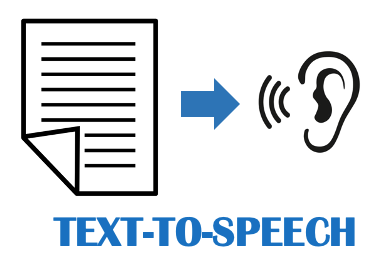Accessing Print with Text-to-Speech Technology
What does the research say?

Estimates suggest that 80% of students with learning disabilities receive services for a reading disability. As many as 8 of 10 students with learning disabilities have reading problems so significant that they cannot read and understand grade-level material (Lerner, 2003). One way to help students access grade level material is using Text-to-Speech (TTS). TTS refers to tools that are designed to change digital text to speech and allows that digital text to be read aloud. Providing text-to-speech allows students to have access to grade level materials and listening to the text allows them to broaden their vocabulary as well as gain new information. The additional capability of highlighting words as they are read aloud allows students to hear and see text at the same time.
Problems of decoding, fluency and connecting text often affects comprehension. According to Paz at LD Resources Foundation Action (LDRFA), “We recommend the tools that have the option of highlighting the sentence as each word is converted to speech, especially for students, as it gives them a multi-sensory learning experience that can improve their ability to focus, retain information and improve comprehension.” Simultaneous visual and auditory access to text allows students to experience books in a new way.
Understood.org is a non-profit organization dedicated to serving family of children who learn and think differently. In an article titled, Text-to-Speech Technology: What It Is and How It Works, the Understood Team discuss how kids seeing and hearing text when reading provides a multisensory reading experience. They suggest that the combination of seeing and hearing text when reading has several advantages including improving word recognition, increasing the ability to pay attention and remember information, allowing students to focus on comprehension instead of decoding words, among others.
In a document developed for the National Center on Accessible Educational Materials on Audio-Supported Reading and Students with Learning Disabilities, supported reading is defined as a “technology-based technique for reading in which individuals read digital text in conjunction with listening to the text in an audio format such as text-to-speech (TTS)”. Jackson and Karger (2015) discuss that listening and viewing text can serve several functions, “For example, pairing written text with speech helps to sustain engagement during the reading task. Listening while viewing text can connect students directly to the text itself while the meaning of the text can be captured through listening.”
In the article Effects of Highlighting Text on the Reading Ability of Children with Developmental Dyslexia: A Pilot Study by Ikeshita et al. (2018) the researchers observed that “children with developmental dyslexia found it easier to read along when audio was synchronized with text highlighting, particularly for the highlighting style that used a blue band for whole sentences.”
Providing students with disabilities access to the printed page via text-to-speech technology is an important way for them to be able to decode grade level text and be given the opportunity to be more independent in their learning. As discussed, using TTS with the capability of listening and following along with the words being highlighted has many benefits.
AIM-VA was created to provide educators a way to access accessible books, workbooks, reading books and other curriculum-based print materials free-of-charge. Books not currently found in the AIM-VA library, can be produced if requested by an AIM-VA Digital Rights Manager (DRM) in any Virginia public school division. These accessible files for available for use by students who have an Individualized Education Program (IEP) and a confirmed Print Disability. Search for existing books in the Library through the AIM-VA website.
References
Ikeshita, H., Yamaguchi, S., Morioka, T., & Yamazoe, T. (2018). Effects of highlighting text on the reading ability of children with developmental dyslexia: A pilot study. International Journal Of Emerging Technologies In Learning (IJET), 13(09), pp. 239-251. doi:http://dx.doi.org/10.3991/ijet.v13i09.8736
Jackson, R.M. & Karger, J. (2015). Audio-supported reading and students with learning disabilities. Wakefield, MA: National Center on Accessible Educational Materials. Retrieved on [3/3/21] from http://aem.cast.org/about/publications/2015/audio-supported-reading-learning-disabilities-asr-ld.html
National Center on Accessible Educational Materials (2015). Audio-supported reading and students with learning disabilities. Wakefield, MA: National Center on Accessible Educational Materials. Retrieved [3/4/21] from http://aem.cast.org/about/publications/2015/audio-supported-reading-learning-disabilities-asr-ld.html
Lerner, J. (2003). Learning disabilities: Theories, diagnosis, and teaching strategies (9th ed.) Boston: Houghton Mifflin.
Pax, Z. (n.d.). Text to speech technology and top reading tools for dyslexia/learning disabilities. Retrieved on [3/7/21] from https://www.ldrfa.org/text-to-speech-technology-and-top-reading-tools-for-dyslexia-learning-disabilities/
Understood.org. (n.d.). Retrieved on [3/7/21] from https://www.understood.org/en/school-learning/assistive-technology/assistive-technologies-basics/text-to-speech-technology-what-it-is-and-how-it-works







